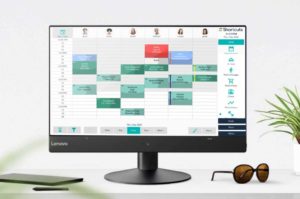
Performance reviews can be daunting for your employees, as there is a lot of work required from management to ensure that they run smoothly and effectively.
It can be difficult to know how to evaluate your salon staff, which is why we’ve compiled a list to help you structure every appraisal.
Using Salon Software to Evaluate Your Staff
Before we get into how to evaluate your staff, let’s think about your data. How are you currently measuring your individual employee performance? Or, better yet, are you collecting staff performance data at all?
When it comes to the appraisal process, evaluating soft skills – such as problem solving and teamwork – is crucial, and you can’t necessarily put a number to these.
But equally, the numbers don’t lie. It’s always important to look at quantitative data, and Shortcuts software makes this easier than ever.
You will gain the ins and outs of your staff performance at the touch of a button, from their attendance to their retail upsell, and everything in between.
So, not only will you be fully prepared for every appraisal, but the stress of managing a team on a daily basis will be alleviated.

How to Evaluate Your Salon Staff For Their Next Performance Review
It’s time to prepare for your employee’s appraisal. Here are some key things that you should evaluate in every performance review.
Note: Appraisals provide the perfect opportunity to set new goals and have an open conversation to make improvements. However, all employee expectations should be explained before an appraisal, so your staff are not met with a surprise.
For example, if you wish to start measuring retail upsell rates, staff should know well in advance. No one wants to be criticized for failing to meet expectations that they weren’t aware of.
-
Attendance
Good attendance is a favorable favorable attribute for your employees to have. When one employee doesn’t turn up to work, it can damage overall morale, as it can put extra pressure on other team members.
Fundamentally, it is important that your staff look after their physical and mental health. But good attendance also means that your staff are punctual for all their duties, stay on the job all day and attend all of their appointments.
If a team member has poor attendance, this gives you the opportunity to have an open discussion, to see if there is anything that could help. For example, it may be that they are struggling to maintain a healthy work-life balance.
-
Job-specific skill development
Skill development could look different depending on the employee’s role. For example, a hairstylist might have developed new skills in freehand color, whereas a front of the house might have developed their customer service skills.
It can be helpful to make this an open conversation. Note down any skills you have noticed developments in, but also ask your team member what skills they think they have improved on the most.
This could spark a conversation about career development. For example, if your employee is excellent at color services, there’s a high chance they could specialize in color-oriented roles.
-
Client retention rate
The salon industry average for first-time client retention rate is around 30%. However, your client retention goals should be individual to your salon.
Often, salons that target an older demographic will see higher retention rates, whereas younger clientele is known for being less committed.
Evaluating your salon staff’s client retention rate can help you flag areas for improvement. Perhaps there are patterns in clients who are not returning. For example, maybe your stylist is not retaining people who have had a balayage with them – in which case your employee may need more balayage training.
Client retention rate is just one of the employee performance metrics that you can track using our Shortcuts Salon Software. Learn more about Shortcuts features.
-
Client feedback and reviews
As a salon owner or manager, it is impossible to be in all places at once. You rely on your staff to have integrity in the moments you are not present.
This is where client reviews can provide you with the bigger picture. It is so important to praise your staff for the great feedback they get in reviews.
If your employee receives negative feedback, it is always best to ask them what happened before you talk about it. There are always two sides to every story, and trust in your staff always comes first!
-
Retail upsells
Retail upsells reveal how successful your employees are taking clients through the sales journey.
If these numbers are a little low, it may be that you need to train your staff on the products themselves, or simply how to upsell products after an appointment.

-
Personal targets achieved
Appraisals provide the perfect opportunity to reflect on the period and evaluate the personal targets achieved by the team member.
This could be absolutely anything that your employee set out to achieve. For example, they may have strived to improve their color skills or work on their social media page. How were they proactive in achieving these goals?
If your employee has no personal targets, the appraisal is a great time to set them. It means you can have these goals on record, and regularly review them.
-
Soft skills
Soft skills are general skills that can be found in just about every workplace. They usually develop naturally with experience, however, it is always important to evaluate your employee’s strengths and weaknesses to help them improve.
Examples of soft skills to evaluate include:
- Professionalism
- Teamwork
- Communication
- Creative thinking
- Problem-solving
- Motivation
- Time management
Whilst you can identify areas of strength and weakness, there is no use telling your staff “you are not so good at time management.” Instead, create an actionable plan to give your employee more experience with this particular skill.
-
Training and education
Finally, since performance reviews are in place to help your staff improve, it can be helpful to reflect on any training or education completed. Did the employee find this training useful, and have you seen improvements due to this training?
By evaluating all of the above, you can talk about what training courses your employee might find useful to further develop in their career. Or, it may be that your employee is generally interested in gaining more skills in an area, despite already performing effectively.
Either way, discussing training will end the appraisal on an optimistic note, as your employee will feel confident that they have an actionable way to improve.

Summary: How To Evaluate Your Salon Staff For Performance Reviews
- Attendance
- Job-specific skill development
- Client retention rate
- Client feedback and reviews
- Retail upsells
- Personal targets achieved
- Soft skills
- Training and education
Get Started with Shortcuts To Stay On-Top Of Employee Performance
Shortcuts software is a game-changer for you and your business. Not only can you track employee performance metrics, but we’ll help you simplify your daily tasks, automate the essentials and manage your clients effortlessly.
New customer? Learn more about us here.
If you are an existing customer, chat with our team here to upgrade to Shortcuts 8.1!







